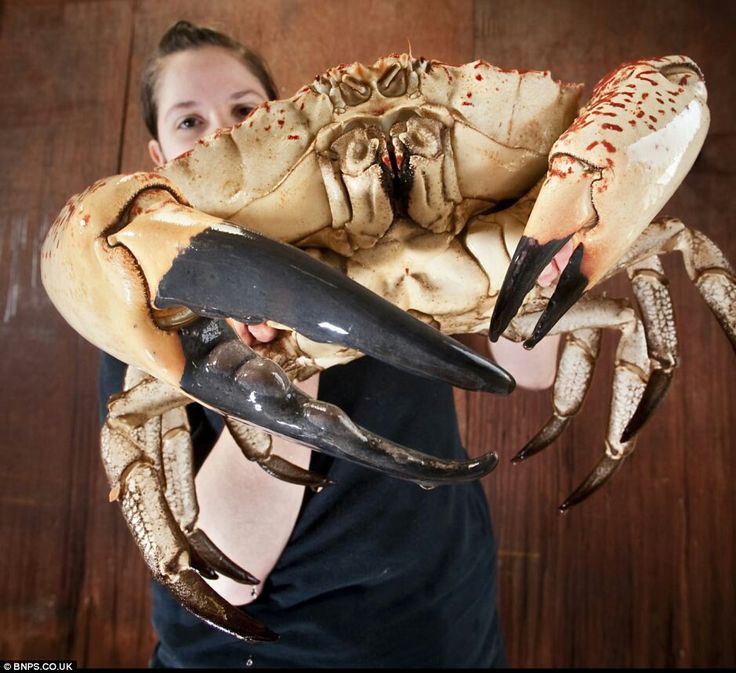The Tasmanian King Crab, scientifically known as Pseudocarcinus gigas, stands as one of the most impressive crustaceans in our oceans.
With its remarkable size, unique coloration, and powerful claws, this crab has fascinated marine biologists and seafood lovers alike.
In this article, we’ll explore the characteristics, habitat, feeding habits, and breeding behaviors of this fascinating species.
Physical Characteristics
The Tasmanian King Crab is renowned for its substantial size.
Male crabs can weigh up to 17.6 kg (39 lbs), boasting a carapace width that can reach an astonishing 46 cm (18 inches).
Females, on the other hand, are considerably smaller, typically not exceeding 7 kg (15 lbs).

This size difference is common in many crab species, with males often being larger to compete for mates.
In terms of appearance, these crabs exhibit a striking color palette.
They are generally whitish-yellow on the underside and a vibrant red on top, adorned with distinctive black-tipped claws.
One of the most notable features of the male Tasmanian King Crab is its oversized claw, which can be longer than the carapace itself.
This claw is not just for show; it serves a crucial role in the crab’s survival.
Habitat and Distribution
The Tasmanian King Crab inhabits the waters off the coast of Southern Australia, thriving in depths ranging from 20 to 820 meters.
These crabs show a preference for rocky and muddy bottoms, which provide ample hiding spots and hunting grounds.
Interestingly, their population density varies with the seasons; they are most abundant at depths of 110 to 180 meters during summer and 190 to 400 meters in winter.

This adaptability to varying depths and conditions highlights the resilience of the Tasmanian King Crab, allowing it to thrive in the often harsh and unpredictable marine environment.
Understanding its habitat is essential for effective conservation efforts and sustainable fishing practices.
Feeding Habits
The Tasmanian King Crab is an opportunistic feeder, known for its varied diet.
It primarily preys on carrion and slow-moving species such as gastropods, crustaceans, and starfish.
The crab’s powerful claws are well-adapted for crushing and breaking open the hard shells of its prey, allowing it to access the nutritious meat inside.

This predatory behavior not only plays a role in the crab’s survival but also helps maintain the ecological balance in its habitat.
By preying on weaker organisms, the Tasmanian King Crab helps control their populations, ensuring a diverse and healthy marine ecosystem.
Reproduction and Lifespan
Breeding for the Tasmanian King Crab typically occurs in June and July, marking a crucial time in their life cycle.
During this period, females can carry up to 2 million eggs, showcasing the species’ remarkable reproductive capability.
After fertilization, the eggs are carried for about four months before hatching.
The lifecycle of the Tasmanian King Crab is marked by slow growth and long lifespan.
Juveniles undergo molting every three to four years, a process vital for their development as they transition from vulnerable young crabs to formidable adults.
This slow growth rate can be attributed to the cold, deep-sea environment they inhabit, which influences their metabolic processes and overall development.
Conservation Status
While the Tasmanian King Crab is not currently classified as endangered, it faces several threats that could impact its populations.
Overfishing, habitat destruction, and climate change are significant concerns for this species.
As demand for seafood continues to rise, sustainable fishing practices become increasingly essential to protect the Tasmanian King Crab and its habitat.

Conservation efforts must also focus on preserving the delicate ecosystems where these crabs thrive.
Initiatives aimed at reducing pollution, protecting breeding grounds, and regulating fishing quotas will be crucial in ensuring the long-term survival of the Tasmanian King Crab.
Cultural and Economic Importance
The Tasmanian King Crab holds significant cultural and economic value in Southern Australia.
It is a sought-after delicacy, known for its sweet and tender meat. As a result, it plays a vital role in the local fishing industry and contributes to the region’s economy.

However, with great demand comes the responsibility of ensuring that fishing practices are sustainable.
Consumers can play a role in this by choosing seafood certified by reputable sustainability standards, supporting fisheries that prioritize responsible practices, and advocating for conservation initiatives.
Conclusion
The Tasmanian King Crab, or Pseudocarcinus gigas, is not just a remarkable marine creature due to its size and unique features; it also plays a vital role in its ecosystem.
From its impressive physical characteristics to its complex feeding habits and breeding cycles, this crab offers a fascinating glimpse into the diverse and intricate world of marine life.
As we continue to explore and understand this incredible species, it becomes increasingly clear that we must prioritize conservation efforts to protect its future.

By ensuring sustainable fishing practices and preserving its habitat, we can help secure the survival of the Tasmanian King Crab for generations to come.
In celebrating the Tasmanian King Crab, we honor not only its existence but also the vibrant ecosystems it inhabits and the communities that depend on its presence.
Through education and conservation, we can foster a deeper appreciation for this majestic creature and the rich biodiversity of our oceans.








